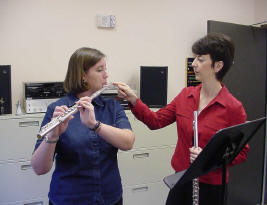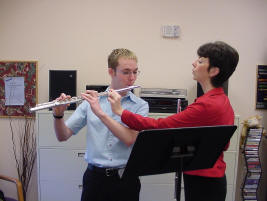|
The "Art" in Articulation by |
Definitions
Single Tonguing
Double Tonguing
Triple Tonguing
Practice Tips
OED: To divide (vocal sound) into distinct parts (words and syllables) each representing a notion or relation.
La Primand. Fr. Acad. (1594): This instrument fashioneth the voyce, & causeth it to yield a sound & so prepareth it for the tongue, that it may be articulated and framed into speech by y' same.
Quantz (1752): The tongue is the means by which we give animation to the execution of the notes up on the flute. It is indispensable for musical articulation, and serves the same purpose as the bow-stroke upon the violin.
Sadie
(1988):
Articulation is the separation of successive notes from one another,
singly or in groups, by a performer, and the manner in which
this is done.
 SINGLE TONGUING
SINGLE TONGUING
The tongue is needed for
making a clear and precise beginning to a note. Air support and
tongue placement are crucial in achieving this clarity. Relax the
back of the tongue, allow the air to flow over, and use only the
tip of the tongue to make the desired "t" sound. The most
sparkling notes are produced by tonguing very far forward in the
mouth; that is, with the tongue tip resting on the top lip. Try
the vowel sound "e" while forming the lips for "o".
Other sounds can be made by varying
the oral cavity and altering the tongue position. Tonguing far
back in the mouth or using the bottom of the tongue instead of the
tip results in imprecise attacks. Holding the back of the tongue
tightly likewise creates imprecision and a “heavy” tongue.
DOUBLE TONGUING
Double tonguing uses two parts
of the tongue to produce a "T" sound followed by a
"K" sound. For rapidly articulated notes the consonants
"D" and "C" yield better results. Attention
must be paid to the second syllable so that it matches the first
one in strength and tone quality. Be sure to keep a constant
supply of pressurized air moving from the lungs through the mouth
to avoid tightening the back of the tongue and or closing the
vocal folds. Should this tension arise, the resulting sound is
"TUkah, TUkah." The tongue does not move much from
the T to the K in double tonguing, nor does it move from front
to back; think of moving it up and down.
TRIPLE TONGUING
There are two main ways to triple
tongue on the flute:
TKT TKT TKT TKT, which is good for music with accents every third
note, and TKT KTK TKT KTh, which is good for groups of six notes,
odd-numbered patterns (five or seven), and for great speed. The
second method, since it merely shifts the accents of double tonguing,
then becomes a technique already mastered. It also eliminates
the slower double consonant, which is why multiple articulations
were developed in the first place.
PRACTICE TIPS
-- Use more air and less tongue. As Donald Peck says, there
is "too much tongue in tonguing." The tongue interrupts
the air stream; it does not stop it. Maintain or increase the
air pressure and allow the tongue to glide on the air stream.
Practicing breath attacks will improve articulation.
-- Keep the aperture small. The heavy tongue muscle can cause the lips to blow apart, and the resulting tone is unclear. A smaller lip opening will also help maintain air speed.
-- Experiment with different vowel sounds and tongue placement. Try variations of the vowels o, e, and u to improve brightness and clarity. Placing the tongue further back in the mouth will likewise change the sound.
--Tongue pianissimo when the dynamic level is fortissimo. Air pressure and volume create the intended dynamic level, not the tongue.
-- Use the air to create note length. The tongue does not determine length of the note. Avoid holding the back of the tongue in a rigid manner in an effort to sustain a tone.
-- Perfect the basics, then adapt them to the needs of the music. Articulating on the flute relates directly to bowing on a string instrument. Learn the basic bow strokes by watching and listening good string players, then try to emulate those sounds on the flute.
-- Practice varying tongue/slur patterns. Problems generally arise when the back of the tongue is tense and/or the air is blocked. The Taffanel/ Gaubert Seventeen Daily Exercises and M.A. Reichert Seven Daily Studies contain excellent examples of various tongue/slur combinations, and Michel Debost's "Gamme Game" for Taffanel/ Gaubert No. 4 is particularly effective.
-- Learn to use other types of tonguing. Try to flutter tongue by rolling R's or vibrating the uvula. Tongue between the lips or with the lips only ("P" sound) to produce delicate entrances. Soften the "T" to a "D" to create a less pointed legato articulation.
| If you would like to be added to the TSMP Email Mailing List and receive periodic notifications of new articles and updates to this website, then please email TSMP.
The Texas School Music
Project is a source for ideas and information
concerning pedagogical
practices in the music classroom or rehearsal hall. The TSMP is a service provided to
all music specialists by the faculty
of
the Department of Music
at Stephen F. Austin State University. Copyright © 2002, Department of Music at Stephen F. Austin State University |
_small.jpg)